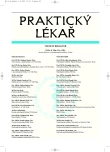Neuronal basis of personality and intelligence.
Authors:
F. Koukolík
Authors‘ workplace:
Primář: MUDr. František Koukolík, DrSc.
; Národní referenční laboratoř prionových chorob
; Fakultní Thomayerova nemocnice s poliklinikou, Praha
; Oddělení patologie a molekulární medicíny
Published in:
Prakt. Lék. 2009; 89(4): 188-193
Category:
Various Specialization
Overview
The advent of functional neuroimaging methods has given us a unique opportunity to analyze brain correlation to personality and intelligence. Personality characteristics describe distinctive and recurrent patterns of thoughts, feelings, and actions that occur in response to particular situational demands. Modern functional neuroimaging methods map the specific human brain regions associated with some dimensions of personality, e.g. extraversion and neuroticism. A short review of functional and structural neuroimaging paradigms reports brain-intelligence correlation too.
Key words:
brain, personality, intelligence.
Sources
1. Blankstein, U., Chen, J.Y., Mincic, A.M. et al. The complex minds of teenagers: neuroanatomy and personality differs between sexes. Neuropsychologia 2009, 47, p. 599-603.
2. Colom, R., Jung, R.E. Haier, R.J. Distributed brain sites for the g-factor of inteligence. Neuroimage 2006, 31, p. 1359-1365.
3. Costa, P.T., McCrae, R.R. Revised NEO Personality inventory and NEO Five Factor Inventory Profession Manual. Odessa, FL, Psychological Assessment Resources 1992. âeská verze: Hfiebíãková , M. NEO osobnostní inventáfi. 1. ãeské vydání. Praha: Testcentrum, 2004.
4. Cloninger, C.R., Svrakic, D.M., Przybeck, T.R. A psychobiological model of temperament and character. Arch. Gen. Psychiatry 1993; 50: p. 975-990.
5. Cloninger, C.R., Przybeck, T.R., Svrakic, D.M. et al. The temperament and character inventory: A guide to its development and use. Washington University Center for Psychobiology of Personality, St. Louis, Missouri, 1994.
6. Cohen, M.X., Schoene-Bake, J.C., Elger, C.E. et al. Connectivity-based segregation of the human striatum predicts personality characteristics. Nature Neurosci 2009, 12, p. 32-34.
7. Deckersbach, T., Miller, K.K., Klibanski, A. et al.: Regional cerebral brain metabolism correlates of neuroticismu and extraversion. Depression Anxiety 2006, 23, p. 133-138.
8. DSM IV TM. Diagnostic and statistical manual of mental disorders. IVth edition. American Psychiatric Association, Washington DC, 1994.
9. Duncan, J., Owen, A.M. Common regions of the human frontal lobe recruited by
diverse cognitive demands. Trends Neurosci. 2000, 23, p. 475 – 483.
10. Duncan, J., Seitz, R.J., Kolodny, J. et al. A neural basis for general inteligence. Science 2000, 289, p. 457-460.
11. Gardner, H. Frames of mind: The theory of multiple intelligences. New York: Basic Books, 1993.
12 Gottfredson, L.S. Intelligence and social policy. Intelligence 1997, 24(1), Dostupné na http://www. udel.edu/educ/gottfredson/reprints/1997specialissue.pdf.
13. Harenski, C.L., Kim, S.H., Haman, S. Neuroticism and psychopathy predict brain activation during moral and nonmoral motion regulation. Cogn. Affect. Behav. Neurosci. 2009, 9, p. 1-15.
14. Hutcherson, C.A., Goldin, P.R., Ramel, W. et al. Attention and emotion influence the relationship between extraversion and neuronal response. SCAN 2008, 3, p. 71-79.
15. Jung, R.E., Haier, R.J. The parieto-frontal integration theroy (P-FIT) of intelligence: converging neuroimaging evidence. Behav. Brain Sci. 2007, 30, p. 135-154.
16. Kim, S.H., Hwang, J.H., Park, H.S. et al. Resting brain metabolism correlates of neuroticism and extraversion in young men. Neuroreport 2008, 19, p. 883-886.
17. Luders, E., Narr, K.L., Thomson, P.M. et al. Neuroanatomical correlates of inteligence. Inteligence 2008;doi:10.1016/j.intell.2008.07.002.
18. Narr, K.L., Woods, R., Thomson, P.M. et al. Relationship between IQ and regional cortical gray matter thickness in healthy adults. Cerebral Cortex 2007, 17, p. 2136-2171.
19. Omura, K., Todd-Constabel, R., Canli, T. Amygdala gray matter concentration is associated with extraversion and neuroticism. Neuroreport 2005, 16, p. 1905-1908.
20. Song, M., Zhou, Y., Li, J. et al. Brain spontaneous functional connectivity and intelligence. Neuroimage 2008, 41, 1168–1176.
21. Sternborg, R.J., Salter, W. Handbook of human intelligence. Cambridge, UK: Cambridge University Press, 1982.
22. Sternberg, R.J. The holey grail of general intelligence. Science 2000, 289, p. 399–400.
23. Wright, Ch.I., Williams, D., Feczko, E. et al. Neuroanatomical correlates of extraversion and neuroticism. Cerebral Cortex 2006, 16, p. 1809-1819.
Labels
General practitioner for children and adolescents General practitioner for adultsArticle was published in
General Practitioner

2009 Issue 4
- Hope Awakens with Early Diagnosis of Parkinson's Disease Based on Skin Odor
- Metamizole at a Glance and in Practice – Effective Non-Opioid Analgesic for All Ages
- Memantine Eases Daily Life for Patients and Caregivers
- Metamizole vs. Tramadol in Postoperative Analgesia
- Memantine in Dementia Therapy – Current Findings and Possible Future Applications
Most read in this issue
- Lichen sclerosus
- Detection of latent tuberculosis, QuantiFERON-TB Gold test, possibilities and pitfalls of the method
- Microvascular decompression of cranial nerves – effect and risk of treatment
- Current overview of the diagnosis and treatment of cancer of the stomach
